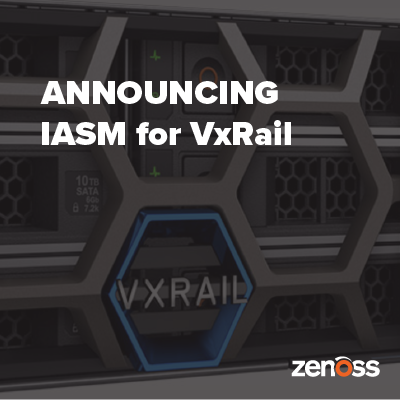
Hyperconverged infrastructure (HCI) can dramatically simplify the management overhead of IT infrastructure by abstracting and automating many of the configuration, care and feeding tasks that more legacy IT platforms can require. Combining HCI and its management stack with a monitoring platform like Zenoss can provide enterprise clients with a solid foundation for intelligent application and service monitoring (IASM), which successful transformation initiatives need to thrive.
With the most recent release of the ZenPacks for Dell PowerEdge and VMware vSphere, Zenoss formally extends IASM operations to Dell EMC VxRail infrastructure, the only fully integrated, pre-configured, and pre-tested VMware hyperconverged system on the market. Zenoss now provides the most comprehensive view of any VxRail HCI appliance. We:
- Provide capabilities to visualize health and status of the entire stack — from the resources in the virtualization layer to the underlying hardware powered by the Dell PowerEdge platform
- Tie in various software elements of the VMware stack to the underlying hardware elements powered by Dell PowerEdge, including vSAN data stores
- Give a comprehensive view into all vSAN clusters with user-driven, on-demand health reporting
- Show a set of graphs to provide insight into the health, status and capacity for vSAN infrastructure elements (e.g., hosts, virtual machines, disk groups, etc.)
- Grant insight into defined policies across vSAN clusters, which helps avoid application downtime because of storage compliance issues
The key benefit Zenoss provides is clear visibility of IT status through deep infrastructure metrics collection coupled with a broad understanding of how different technology components work together to deliver a business service. With these new integration capabilities, Zenoss maps out not only the VxRail resources but also all associated mission-critical services they enable. This gives users the ability to see when and where issues are occuring, identify affected services that rely on VxRail infrastructure, and quickly pinpoint and resolve issues hindering service delivery. Zenoss also maintains a rich history of these data points over time so system performance can be explored retrospectively. Our AIOps algorithms utilize this historical data to identify anomalous behavior and help head off future issues before they occur.
Additionally, there are probably quite a few systems running legacy workloads that will persist for some time to come, and organizations still need to be able to maintain visibility into their health. These infrastructure components can include servers, networking hardware, detached storage, power supplies, CRAC units, etc. Zenoss pulls data points from all of these IT resources, storing them in the same repository alongside the data it senses from VxRail infrastructure. This means that exploring the infrastructure performance of any resource in your entire data center is just a few queries away in the Zenoss interface.
To learn more about how Zenoss integrates with VxRail HCI and other dynamic, modern IT environments, request a demo today.







